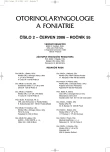Genetické a elektrofyziologické pozadí vnímání tinnitu u pacientů s kochleární percepční poruchou sluchu
Genetic Electrophysiological Background of Perception of Tinnitus in Patients with Cochlear Perception Disorder of Hearing
Summary:
The disinhibitory feedback hypothesis of the tinnitus generation is based on feedback regulation of neural activity in the ascendent part auditory pathways via inhibition or activation of descendent auditory connections. To support or reject this hypothesis the relationship between markers of disinhibition in AEP and tinnitus manifestation could be studied. Additionally, the differences in genetic background of receptor systems of the auditory pathways having influence to the tinnitus manifestation may establish the site and structure responsible for the tinnitus generation. A group of 105 patients with cochlear sensorineural hearing loss was studied from the standpoints of tinnitus manifestation, BAEP and MLR and analysis of genetic polymorphisms – Taq I polymorphism of DRD2 receptor, 10 intron +101 C/T and 1275 A/G polymorphism of GRIN2a subunit of NMDA receptor, 2664 C/T polymorphism in the GRIN2b subunit of NMDA receptor and CA repeat in gene of GABRß3 subunit of GABAA receptor. Following dependencies were found: the tinnitus manifestation correlated well with the V/III amplitude ratio of BAEP (p<0.001) and PA amplitude of MLR (p<0.001). The tinnitus manifestation differed significantly in dependence to genotype of CA repeat in gene of GABRß3 subunit (p=0.04). Polymorphism 2664 C/T in the GRIN2b subunit of NMDA receptor influenced the electrophysiological markers of disinhibition, but this difference was only marginally significant (min. p=0.07). These results may support the disinhibitory feedback hypothesis of tinnitus generation.
Key words:
tinnitus, BAEP, MLR, disinhibition, genetic polymorphism, GABA-A receptor.
Autoři:
J. Rottenberg; R. Kostřica; M. Žallmann; Michal Jurajda 1
Působiště autorů:
Klinika otorinolaryngologie a chirurgie hlavy a krku LF MU a FN u sv. Anny, Brno
; Ústav patologické fyziologie LF MU, Brno
1
Vyšlo v časopise:
Otorinolaryngol Foniatr, 55, 2006, No. 2, pp. 96-102.
Kategorie:
Původní práce
Souhrn
Souhrn:
Desinhibiční hypotéza vzniku tinnitu je založena na existenci zpětnovazebné regulace neurální aktivity v ascendentní části sluchové dráhy cestou inhibice nebo aktivace descendentními neurálními spoji. Abychom mohli podpořit nebo vyvrátit tuto hypotézu, studovali jsme vztah mezi markery desinhibice ve sluchové dráze při registraci AEP a manifestací tinnitu. Variabilita genetického pozadí receptorů sluchové dráhy ve vztahu k manifestaci tinnitu může rovněž napomoci ke zjištění místa a struktury odpovědné za vznik tinnitu. Soubor 105 pacientů s kochleární percepční nedoslýchavostí byl sledován z hlediska manifestace tinnitu, byly měřeny BAEP a MLR a byla provedena analýza genetických polymorfismů – Taq I polymorfismus DRD2 receptoru, +101 C/T v 10. intronu a 1275 A/G polymorfismus GRIN2a podjednotky a 2664 C/T polymorfismus GRIN2b podjednotky NMDA receptoru a CA repetitivní sekvence v genu pro GABRß3 podjednotku pro GABAA receptor. Byly nalezeny následující závislosti: manifestace tinnitu dobře korelovala s poměrem amplitud vln V/III (p<0,001) a s amplitudou vlny PA odpovědi MLR (p<0,001). Manifestace tinnitu závisela rovněž na genotypu u CA repetitivní sekvence genu pro GABRß3 podjednotku (p=0,04). Polymorfismus 2664 C/T GRIN2b podjednotky NMDA receptoru měl vliv na variabilitu elektrofyziologických markerů desinhibice, ale tato závislost byla pouze marginální (min. p=0,07). Tyto výsledky mohou podporovat desinhibiční hypotézu vzniku tinnitu.
Klíčová slova:
tinnitus, BAEP, MLR, desinhibice, genetický polymorfismus, GABA-A receptor.
Štítky
Audiologie a foniatrie Dětská otorinolaryngologie OtorinolaryngologieČlánek vyšel v časopise
Otorinolaryngologie a foniatrie

2006 Číslo 2
- Isoprinosin je bezpečný a účinný v léčbě pacientů s akutní respirační virovou infekcí
- Pacienti s infekcemi HPV a EBV a možnosti léčebné intervence pomocí inosin pranobexu
- Fexofenadin – nesedativní a imunomodulační antihistaminikum v léčbě alergických projevů
- Doc. Jiří Kubeš: Zásadní přínos protonové terapie spočívá v ochraně zdravých tkání
- Sekundární imunodeficience: příčiny, projevy, diagnostika a možnosti léčby
Nejčtenější v tomto čísle
- Tonzilektómie za tepla a za studena
- Uzlinové krční metastázy spinocelulárního karcinomu orofaryngu a hrtanu (2. část)
- Slizniční melanomy hlavy a krku
- Chirurgická léčba cholesteatomu
